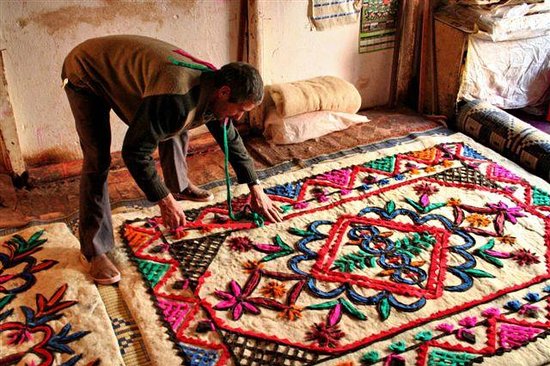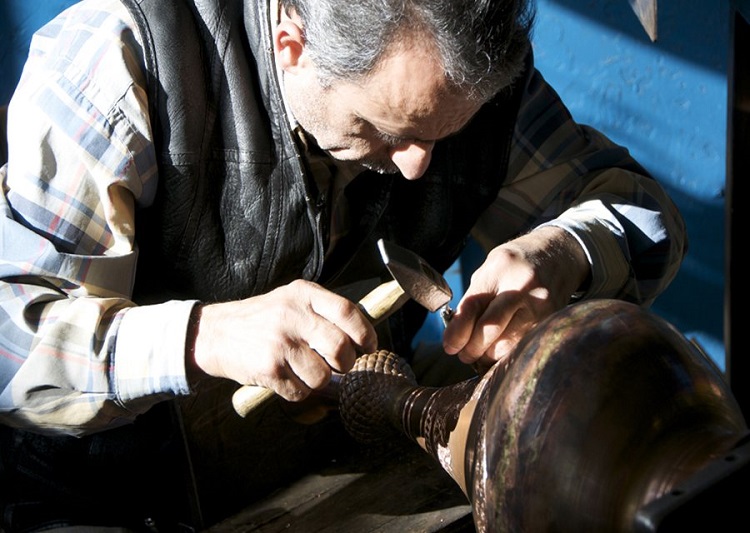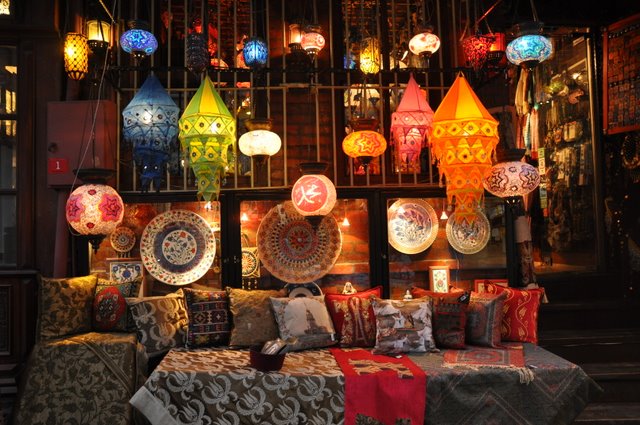A Brief History of Turkey: Her Culture and Handicrafts
For approximately five millennia, the area of Asia Minor that we now call Turkey has played a central role in the economic, cultural, and political life of both Europe and the Middle East. Originally known as Anatolia (meaning “the East” or “Sunrise”) the area was inhabited by tribes known as Hattians and Hurrians at least 44 centuries ago. These tribes were followed by the Hittites who ruled the area for some 700 years before their empire collapsed in about 1200 B.C.
In the wake of the Hittite collapse, a variety of tribes vied for control of the area with none establishing absolute rule until the Persians invaded in the 6 th Century B.C. Persian rule of Anatolia lasted until 335 BC when Alexander the Great invaded. Alexander introduced Greek language and culture to the area which had the effect of killing off the native Anatolian languages. In 190 B.C. the armies of the Roman Republic invaded and won the decisive Battle of Magnesia against local King Antiochus III. This victory effectively established Roman/Byzantine control of the area for the next 1,500 years.
In 1453, the Ottoman Turks conquered Constantinople marking a definitive end to the Eastern Roman, or Byzantine, empire. After less than 150 years, however, the Ottoman Empire began a long and inexorable slide into decadence and irrelevance, culminating with their disastrous loss in World War I. The Turks were not of a mind to accept the terms of surrender being offered them by the victorious allies however, and in 1922, led by the charismatic and popular Kemal Atatürk they expelled all occupying forces, and the nation of Turkey was born.
Turkish Culture
Turkey's population is 99% Muslim and, as you might imagine, many of the customs and traditions of the nation revolve around Islamic thought and traditions. Still, Turkey is not a fundamentalist Islamic state, and levels of adherence to the various strictures of Islam vary from region to region. For example: in large cities, it is possible for female visitors to enter a mosque without covering their heads. (Although this is not something a woman would want to do on a regular basis.) This is not the case in more remote areas of the country where Islamic influence is strong. In those areas, a woman will need to cover her head and shoulders and wear skirts that extend below the knee.

One of Atatürk’s most controversial reforms was to abolish the caliphate that had formerly given the Ottoman sultans nominal authority over all Muslims worldwide. Atatürk also restricted the power and influence of religious authorities and greatly reduced religious teaching in schools. He also introduced the Latin alphabet along with Western painting, literature, and even opera. Painting of figures; a practice normally discouraged by Islamic tradition, was allowed and musicians were encouraged to embrace many Western musical forms including jazz (Turkish Jazz Week is a highlight of the cultural calendar each year) and the aforementioned opera.
Turkish literature came late to Western forms like the novel but has produced some incredibly nuanced and important work. Many Turkish writers today write about the country’s downtrodden or outcast and many embrace the Western notion of progress from both a social and individual perspective.
The rich heritage and complexity of Turkish culture are perhaps best personified by Turkish folkloric dance. Turkish folk dance is not a single style of dance but rather a tapestry of different dances that vary from region to region with each incorporating its own subtleties and cultural associations. From the “Haly” and “Bar” in the East to the “Hora” in Thrace and the “Horon” in the Black Sea region Turkish folk dance exhibits an amazing diversity of expression and movement and is regarded by many as one of the most important cultural legacies of the Turkish nation.
Traditional Turkish Handicrafts
Turkey has a well-deserved reputation for producing some of the world’s most beautiful and evocative handicrafts. From embroiderers to silversmiths to weavers and more the craftsmen and women of Turkey have been perfecting their various trades for more than 2 millennia and their work is just as vibrant and rich today as it was in the days of Byzantium and Anatolia. At Paykoc Imports we take great pride in the role we play in bringing dazzling Turkish handicrafts to both the US and online audience. In this post, we’ll look at some of the most important and timeless handicrafts being created in Turkey today.

Handcrafting a Cultural Tradition
Working independently over the centuries in workshops scattered across Asia Minor the Turks and their ancestors have handcrafted a cultural tradition unlike any other. Through an insistence on maintaining the tried and true methodologies of their forebears the timeless qualities of a more elegant age are still with us today in Turkish handicrafts. Some of the most important of these include:
- Turkish Rugs: The Turkish weaving tradition has produced some of the most stunning hand-woven carpets ever created. The Turkish rug is typified by certain color, design, and dye characteristics unique to this part of the world and is usually made of cotton or wool. Turkish rugs can range in size from tiny individual pieces the size of welcome mats to room-size creations fit for palaces. No matter where you look in Turkey you’ll find first-class examples of the skill and dedication of the local rug makers. If you’d like your rug to exhibit more esoteric iconography look to weavers in the far reaches of the country. For rugs with a more urbane feel to them spend some time in the largest markets of Istanbul and Ankara.
- Pottery/Ceramics: The fine art of Turkish pottery today brings with it centuries of tradition and knowledge as well as a multicultural mixture of influences as far-reaching as Alexander the Great and Suleiman the Magnificent. Iznik pottery tradition dates back to the 15th century and played a key role in the development of later ceramic traditions. Iznik tile makers today are renowned the world over for the quality of their products while ceramic artists like Nimet Varli push the cultural envelope with her stunning porcelain creations. Paykoc carries a full line of Nimet porcelain and is proud to promote the work of this social and artistic pioneer.
- Metalworking: Examples of Turkish silver engraving dating back to the 2nd century are vivid proof of the resilience of the metalworking tradition in this part of the world. Turkish craftsmen today are famous for their peerless pots and pans, metal bowls, cauldrons, and more, hand-forged silver and copper. These are no mere tourist trinkets. The metalwork you’ll find today in the bazaars of Turkey is the product of trade secrets passed down from generation to generation through the master/apprentice relationships that still form the backbone of the Turkish metalworking industry.
- Glasswork: Glasswork is another Turkish handicraft that has evolved over the centuries to encompass both the best traditional aspects of purely decorative art as well as the synthesis of the artistic and the practical as manifest in the Turkish mosaic lamp. Mosaic lamps were both the forerunner and inspiration Louis Comfort Tiffany used to create what became known as the Tiffany lamp. Today Turkish mosaic lamps are finally being discovered by a wide Western audience. At Paykoc we offer dozens of variations on the Turkish mosaic lamp; each one a unique creation that will add rich color, timeless mystery, and an air of enduring beauty to any area of your home.
- Embroidery: Turkish embroidery can trace its roots back to the beginning of recorded history in the region. Now, as then, embroidery occupies a distinctive place in the cultural life of the people. Exquisite examples of embroidery can be seen in many traditional Turkish costumes as well as in present-day headscarves, belts, handkerchiefs, pillow coverings, and upholstery of every type. Embroidery has long been one of the most ‘democratic’ of the arts of Asia Minor meaning it was never the exclusive domain of the palace the way fine ceramics were at various times in the past. Turkish embroidery work today eschews the movement toward mechanization that has overtaken much of the craft in other countries and as such Turkish embroidery is still highly prized among connoisseurs.
Final Thoughts
Turkish traditional handicrafts are a major draw for visitors from around the world. Unlike some countries whose markets are likely to be stuffed with the same half dozen or so t-shirts and tiny plastic trinkets stamped out by the millions, Turkey’s public markets are alive with items of dazzling handcrafted quality. These items are a vivid reminder of the value of patient effort that speaks to us even more intimately in our age of profit-driven, planned obsolescence.
At Paykoc Imports we’re proud to celebrate and promote world-renowned Turkish handicrafts. From Zamak earrings, bracelets, and necklaces to stunning Turkish mosaic lamps and the exquisite porcelain creations Nimet Varli. We encourage you to browse our online collections or pay us a visit in our Denver showroom.

 Default Currency
Default Currency
